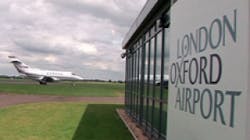DLR experts testing new commercial aircraft designs as part of EU's NACRE program
Posted by John McHaleMUNICH, Germany, 1 April 2011. Experts at the German Aerospace Center (Deutsches Zentrum fur Luft- und Raumfahrt; DLR) are flight testing future passenger aircraft configurations using the flying wing aircraft. The testing is part the European Union project NACRE (New Aircraft Concepts Research). The flying wing is a wide-body aircraft designed for long-haul flights and able to accommodate as many as 750 passengers. The designs have been tested and evaluated using DLR's ATTAS (Advanced Technologies Testing Aircraft System) research aircraft. In addition to conventional mechanical flight controls, ATTAS is also equipped with an electrical flight control system. This allows the researchers to intervene in the flight control system using special hardware and software and give ATTAS the flight characteristics and performance of an entirely different aircraft. Although the pilot is flying an aircraft resembling a small passenger plane, it feels like he is sitting in an aircraft with the fuselage and wings blended into a single entity. With a length of 65 meters, a height of 19 meters, and a span of nearly 100 meters, the maximum take-off weight of the simulated flying wing is roughly 700 tons. Its four engines provide a maximum total thrust of 1,425 kilonewtons. During the test flights the scientists explored the flight characteristics by examining individual maneuvers, such as deliberately varying the aircraft attitude. "With its special control technology, ATTAS can behave like other aircraft while in the air," says Dirk Leibling, a researcher at the DLR Institute of Flight Systems. "This gives us the opportunity to simulate aircraft that do not even exist yet, and to see where we still need to make improvements."First, the aircraft simulation is created using a computer, where a mathematical model defines the dynamic behavior of the new design. This is transferred to the flight control system of ATTAS. The pilot can then test and evaluate the performance of the new aircraft design first hand under real flight conditions.ATTAS is capable of simulating not only standard airplanes, but aircraft with an entirely different aerodynamic design as well, DLR experts say. Flying wings are aircraft resembling fish such as rays or skate. While ATTAS, like all previous passenger aircraft, consists of a cylindrical fuselage with wings and a tail unit, the configuration simulated in the flight tests has a somewhat triangular fuselage. At the tail, two vertical stabilizers that are tilted slightly outwards replace the conventional combination of a tail fin/rudder and a tailplane/elevator. There are four engines under the additional wing area. "The peculiar shape of the aircraft improves its lift characteristics, which in turn increases efficiency," Leibling says regarding the advantages of the flying wing. It is no surprise that flying wings have a great chance of becoming the aircraft of the future and are currently the subject of many studies, he adds.Using a simulated instrument landing system, the pilots tested landing approaches on a virtual runway. Each maneuver was followed by an evaluation of the flying wing's handling characteristics, which showed that the flying wing aircraft is difficult to control due to its unusual shape. Only the introduction of an additional control system developed at DLR brought about the desired results, DLR experts say. This type of control system prevents the aircraft from responding adversely to pilot inputs by initiating appropriate counter-maneuvers. "The flight test confirmed our assumptions," Leibling says. "There is a limit to handling a modern, completely uniquely-shaped aircraft without coordinated flight control laws. We can only achieve the flight characteristics we want by using appropriate computer and control technology."The preliminary results of theoretical investigations could only be confirmed in a tangible way by carrying out simulations during a real flight test; even high-quality simulations on the ground are limited in this respect.
